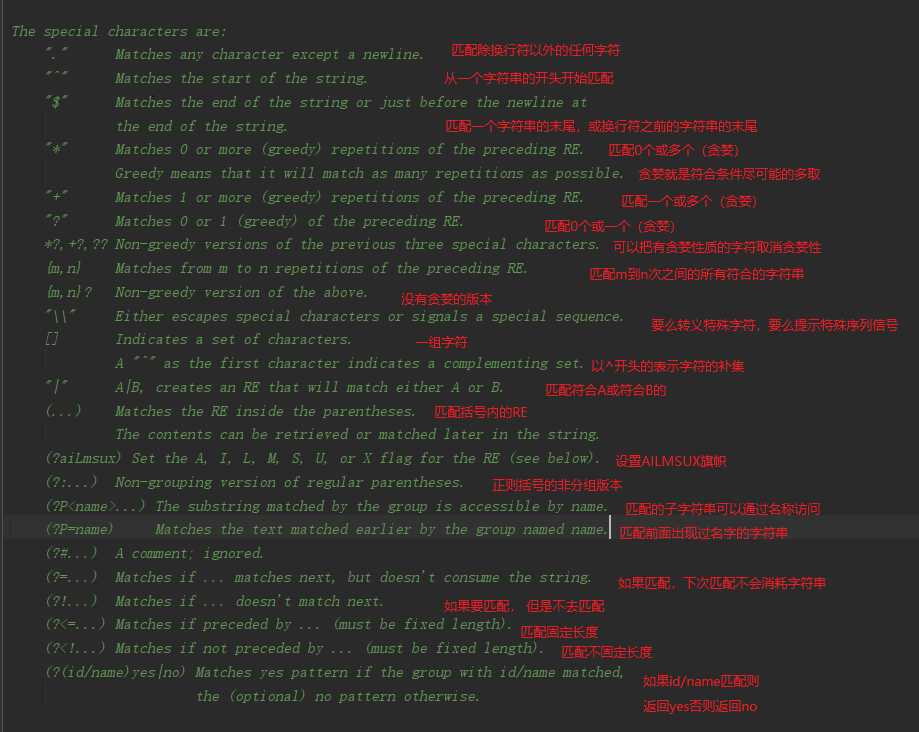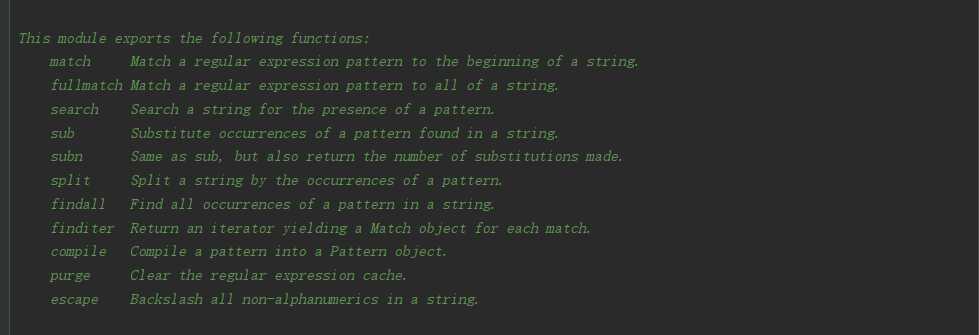标签:就会 表达式 att 获取 切割 用处 bsp 处理 color

这是re模块与正则的结合

re模块提供的函数
1.match 尝试在字符串的开头应用该模式,返回匹配对象,如果没有找到匹配,则为None。
1 import re 2 3 str1 = "Why are you keeping this curiosity door locked?" 4 res = re.match(‘\w+y‘, str1) 5 print(res)

如果要获取匹配的值则需要调用group()方法:
print(res.group())

2. fullmatch 表示匹配全部字符串,返回匹配对象,如果没有找到匹配,则返回None。
import re str1 = "Why are you keeping this curiosity door locked?" res = re.fullmatch(‘\w+y‘, str1) print(res)

import re str1 = "Why" res = re.fullmatch(‘\w+y‘, str1) print(res)

3.search 匹配到第一个符合的字符串就会停止,返回匹配对象,如果没有找到匹配,则返回None。
import re str1 = "Why are you keeping this curiosity door locked? looking foreword" res = re.search(‘\w+g‘, str1) print(res) print(res.group())

match 就相当于 re.search(‘^RE‘, string) (从头开始去匹配)
4. findall 匹配字符串中所有符合的 ,返回匹配对象(列表),如果没有找到匹配,则返回None。
import re str1 = "Why are you keeping this curiosity door locked? looking foreword" res = re.findall(‘\w+g‘, str1) print(res)

5. sub 把匹配到的字符串再用给的字符替换,然后返回新的字符串
sub(pattern, repl, string, count=0, flags=0)
import re str1 = "Why are you keeping this curiosity door locked? looking foreword" res = re.sub(‘ing‘, ‘ed‘, str1) print(res)

import re str1 = "Why are you keeping this curiosity door locked? looking foreword" res = re.subn(‘ing‘, ‘ed‘, str1) print(res)
subn则会告诉你替换了多少处(返回的是一个元祖)

6. split 相当于 字符串的split的用法, 返回切割后的列表
import re str1 = "Why are you keeping this curiosity door locked? looking foreword" res = re.split(‘e‘, str1) print(res)

可以把(RE)用括号括起来就可以把用来切割的 字符串也包含进列表中
import re str1 = "Why are you keeping this curiosity door locked? looking foreword" res = re.split(‘(\we)‘, str1) print(res)

7. compile 先把正则编译,如果需要很多匹配的字符串都用到同一个正则表达式,则可以用compile先把正则编译好,可以节约时间
8.finditer 可以从匹配到的列表里一个一个的获取到数据,经常与compile连用处理比较多的数据
标签:就会 表达式 att 获取 切割 用处 bsp 处理 color
原文地址:https://www.cnblogs.com/hxf-zb/p/11180209.html